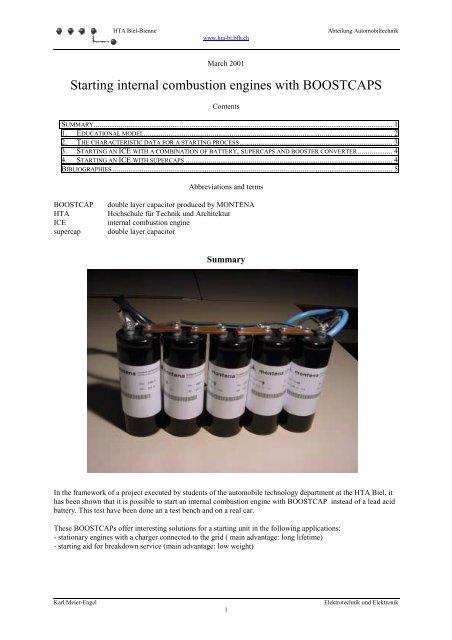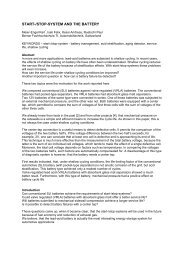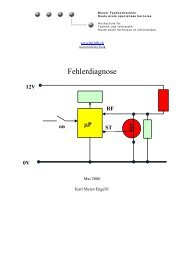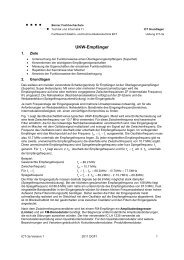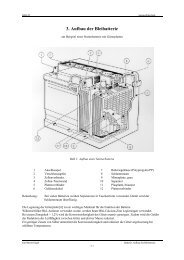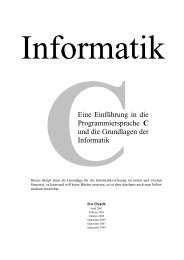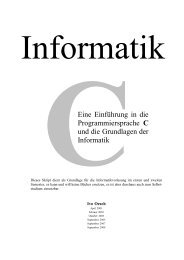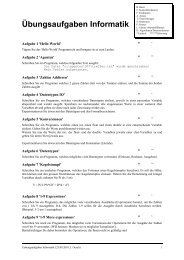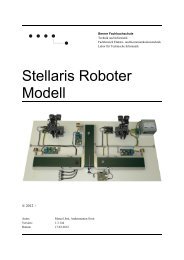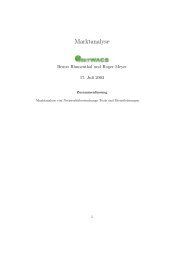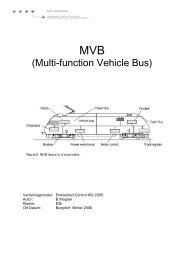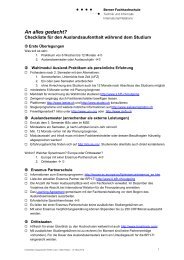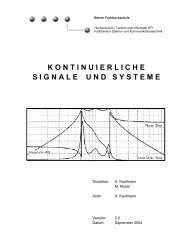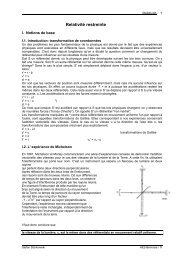Starting internal combustion engines with BOOSTCAPS
Starting internal combustion engines with BOOSTCAPS
Starting internal combustion engines with BOOSTCAPS
Create successful ePaper yourself
Turn your PDF publications into a flip-book with our unique Google optimized e-Paper software.
HTA Biel-Bienne Abteilung Automobiltechnik<br />
www.hta-bi.bfh.ch<br />
March 2001<br />
<strong>Starting</strong> <strong>internal</strong> <strong>combustion</strong> <strong>engines</strong> <strong>with</strong> <strong>BOOSTCAPS</strong><br />
Contents<br />
SUMMARY............................................................................................................................................................ 1<br />
1. EDUCATIONAL MODEL.................................................................................................................................. 2<br />
2. THE CHARACTERISTIC DATA FOR A STARTING PROCESS................................................................................ 3<br />
3. STARTING AN ICE WITH A COMBINATION OF BATTERY, SUPERCAPS AND BOOSTER CONVERTER .................. 4<br />
4. STARTING AN ICE WITH SUPERCAPS ............................................................................................................ 4<br />
BIBLIOGRAPHIES .................................................................................................................................................. 5<br />
Abbreviations and terms<br />
BOOSTCAP double layer capacitor produced by MONTENA<br />
HTA Hochschule für Technik und Architektur<br />
ICE <strong>internal</strong> <strong>combustion</strong> engine<br />
supercap double layer capacitor<br />
Summary<br />
In the framework of a project executed by students of the automobile technology department at the HTA Biel, it<br />
has been shown that it is possible to start an <strong>internal</strong> <strong>combustion</strong> engine <strong>with</strong> BOOSTCAP instead of a lead acid<br />
battery. This test have been done an a test bench and on a real car.<br />
These BOOSTCAPs offer interesting solutions for a starting unit in the following applications:<br />
- stationary <strong>engines</strong> <strong>with</strong> a charger connected to the grid ( main advantage: long lifetime)<br />
- starting aid for breakdown service (main advantage: low weight)<br />
Karl Meier-Engel Elektrotechnik und Elektronik<br />
1
HTA Biel-Bienne Abteilung Automobiltechnik<br />
www.hta-bi.bfh.ch<br />
1. Educational model<br />
Before the relatively new technology of supercaps can be applied, the engineers have to know, how to use this<br />
device properly.<br />
Therefore we developed a simple educational model.<br />
Education model <strong>with</strong> a Supercap of 100 F<br />
The function is quit simple. The supercap will be charged from the DC/DC-converter. The charging current is<br />
fixed <strong>with</strong> a constant value of I = 1 A. The voltage is limited at 1.9 V.<br />
With an ampere meter connected between the DC/DC-converter and the supercap, the students will observe the<br />
charging current <strong>with</strong>in about 200 s.<br />
With the help of the formula [1] the capacity of 100 F can be verified by calculation.<br />
[] 1 C Q I t<br />
= =<br />
U U<br />
∗<br />
If the supercap has reached the voltage of 1.9 V, the DC/DC-converter has to be disconnected. Then the supercap<br />
can be connected to the LED. The LED will be lighted and visible for quite a long time.<br />
After such an introduction the students usually understand why this device could be interesting for automotive<br />
application such as. - accumulation of braking energy<br />
- energy accumulator for hybrid vehicles<br />
- energy accumulator for the starter<br />
Karl Meier-Engel Elektrotechnik und Elektronik<br />
2
HTA Biel-Bienne Abteilung Automobiltechnik<br />
www.hta-bi.bfh.ch<br />
2. The characteristic data for a starting process<br />
The <strong>internal</strong> <strong>combustion</strong> engine (ICE) of a car requires a starter motor <strong>with</strong> a power of about 1 kW.<br />
The open circuit voltage of a lead acid starter battery is 12,8 V and the <strong>internal</strong> resistance is about 12 mΩ.<br />
With the formula [2] we find the following results:<br />
I1 = 981,8 A and I2 = 84,88 A<br />
Because the breakaway torque needs a high current, the battery must be able to produce the value I1 = 982 A. For<br />
this reason a low <strong>internal</strong> resistance is of crucial importance for starter batteries.<br />
[ 2]<br />
I ,<br />
12<br />
2<br />
U0 ± U0 −<br />
4RiP<br />
=<br />
2R<br />
i<br />
Current of a starter (BMW) at 1°C [2]<br />
I1,2 = current [A]<br />
U0 = open circuit voltage [V]<br />
Ri = <strong>internal</strong> resistance [ ]<br />
P = power [W]<br />
The diagram above shows the current of a starter at a temperature of 1°C. At the beginning we see a peak value<br />
of 600 A. This point is very important for the breakaway. That means the engine has to be put in move from the<br />
static position (static friction) into a dynamic state (sliding friction).<br />
After the breakaway current will reach an average of about 130 A, the oscillation of the current is produced by<br />
the compression strokes.<br />
The time necessary to start an ICE will be from 2 – 5 s. The speed of the ICE should reach at least 100 1/min.<br />
[1].<br />
Karl Meier-Engel Elektrotechnik und Elektronik<br />
3
HTA Biel-Bienne Abteilung Automobiltechnik<br />
www.hta-bi.bfh.ch<br />
3. <strong>Starting</strong> an ICE <strong>with</strong> a combination of battery, supercaps and booster converter<br />
[3]<br />
In the framework of a diploma thesis at the HTA Biel the combination of battery, supercaps and booster<br />
converter was used to start an ICE. The main goal was to reduce the weight of the starting unit (starter battery).<br />
Therefore a small battery <strong>with</strong> a capacity of 7 Ah <strong>with</strong> a weight of about 2 – 4 kg was used instead of the standard<br />
lead acid starter battery <strong>with</strong> a capacity of 40 – 50 Ah and a weight of about 15 kg.<br />
Block diagram of the starter unit<br />
Two strings of 3 BOOSTCAP BCAP0005 <strong>with</strong> C = 800 F are producing alternately a voltage of 10 V. The<br />
current <strong>with</strong>in the test achieved a maximum peak of 106 A. The starting unit worked properly on the test bench.<br />
The battery and the supercap unit represents a current divider. Because the <strong>internal</strong> resistance of the power unit<br />
“supercap and booster converter” was higher than the one of the battery, the peak value of the battery current was<br />
also higher. In combination <strong>with</strong> a battery containing a very low <strong>internal</strong> resistance this creates a problem.<br />
Findings<br />
With this solution the total weight of a starter unit can be reduced.<br />
For a parallel connection of a supercap unit and a battery the problem of the current divider must be respected.<br />
4. <strong>Starting</strong> an ICE <strong>with</strong> supercaps<br />
[4]<br />
In the framework of a project for students of the HTA Biel a new generation of <strong>BOOSTCAPS</strong> are used to start<br />
the ICE <strong>with</strong>out the booster converter.<br />
For this purpose we used a Boostcap BCAP0007 <strong>with</strong> the following data [5]:<br />
C = 1'400 F Max. Series Resistance: 1,6 mΩ<br />
UN = 2,5 V<br />
Five boostcaps are built in serial connection to a starter unit. Each boostcap has a 1 kΩ resistor in parallel<br />
connection. The whole unit has a weight of 1,7 kg. (lead-acid starter battery: ~15 kg).<br />
Karl Meier-Engel Elektrotechnik und Elektronik<br />
4
HTA Biel-Bienne Abteilung Automobiltechnik<br />
www.hta-bi.bfh.ch<br />
Current and voltage of a 1 kW starter motor measured on the test bench of HTA Biel [4]<br />
Because of the low <strong>internal</strong> resistance we achieved good results either on the test bench and on a real vehicle.<br />
There is enough energy for multiple starts. With an ICE at about 20°C we have executed more then ten starts.<br />
Findings<br />
- Boostcaps are able to start an ICE.<br />
- The weight of a starting unit <strong>with</strong> supercaps is about 1,7 kg.<br />
- Because the total cycle life should be much higher than the one of a lead acid starter battery, this solution is<br />
very interesting for: - ICE for stationary use<br />
- tool for starting aid (TCS, AAA, garage)<br />
Bibliographies<br />
[1] Bosch: Kraftfahrtechnisches Taschenbuch, 23. Auflage, Vieweg-Verlag, ISBN 3-528-03876-4<br />
[2] Marolf E. / Schwab B.: Anlassdrehmoment eines Motors (BMW), IS Biel, Abteilung<br />
Automobiltechnik, Wahlfacharbeit 1993<br />
[3] Donatucci Domenico: Boostcap, HTA Biel-Bienne, Abteilung Automobiltechnik; Diplomarbeit 1999<br />
[4] Bütikofer S.; Streit A.: Anlassen mit Boostcap; HTA Biel-Bienne; Abteilung Automobiltechnik;<br />
Projektarbeit 2000<br />
[5] Montena: Data sheet<br />
Internet: www.montena.com<br />
Karl Meier-Engel Elektrotechnik und Elektronik<br />
5


